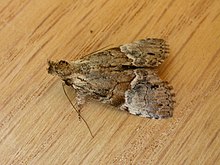| Alophosoma emmelopis | |
|---|---|
 | |
| Scientific classification | |
| Domain: | Eukaryota |
| Kingdom: | Animalia |
| Phylum: | Arthropoda |
| Class: | Insecta |
| Order: | Lepidoptera |
| Superfamily: | Noctuoidea |
| Family: | Noctuidae (?) |
| Genus: | Alophosoma |
| Species: | A. emmelopis |
| Binomial name | |
| Alophosoma emmelopis Turner, 1929 | |
Alophosoma emmelopis, the bicoloured crest, is a moth of the family Noctuidae. The species was first described by Alfred Jefferis Turner in 1929. [1] It is found in Australia. [2]